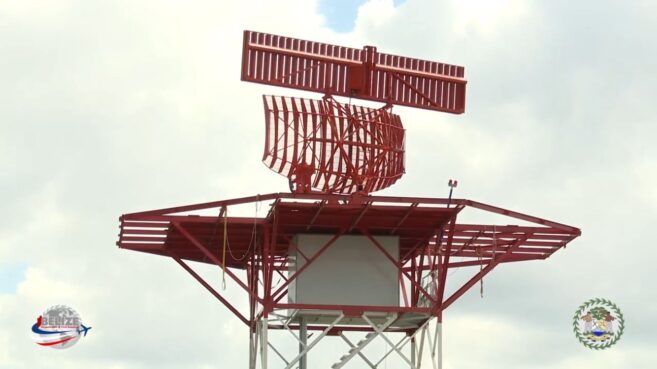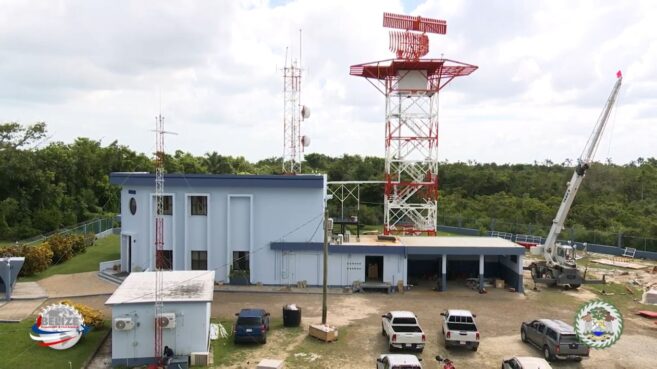The surveillance and monitoring of Belize’s airspace have significantly improved with the acquisition of a primary radar. The Government of Belize shared this accomplishment with the nation on Wednesday, January 17th, indicating that installing this first-ever primary surveillance radar will better monitor the Belizean skies and place the Jewel at the top with one of the most advanced systems in the region.
Director of Civil Aviation Nigel Carter stated that the radar will monitor situational awareness for air traffic controllers and national security. Carter further explained the functions of the crucial l aviation equipment. “The primary surveillance radar, in conjunction with the secondary radar, will allow air traffic controllers to see all the aircraft in our airspace,” said Carter. “The secondary surveillance radar is limited to only seeing aircraft that have transponders on. With the primary surveillance radar, they will be able to see aircraft that do not have any transponders and possibly no radios.” According to Carter, this upgrade will allow air traffic controllers to make better decisions to ensure the aircraft’s safety while navigating through Belize’s airspace.
Carter added that the primary radar will provide coverage for all of Belize’s airspace in conjunction with other regional radars. He said this creates a network of primary surveillance radars that can provide alerts for incoming aircraft.
Chief Executive Officer (CEO) of the Ministry of the Blue Economy and Civil Aviation, Kennedy Carrillo, noted that acquiring this essential infrastructure marks stronger links with other counterparts in Central America. “It will not only strengthen our relations and surveillance of our country as it relates to aviation, but also for national security purposes,” said Carrillo.
The main players in this aviation project
CEO Carrillo explained that Belize only counted with a secondary radar for decades, limiting the country from adequately monitoring the national airspace. In the past, this led to unauthorized aircraft landing in clandestine airstrips in Belize involved in illicit activities. Belize relied on neighboring countries with a primary radar to track the illegal flights.
When the current government took office in 2020, the Area Representative for San Pedro, Ambergris Caye, and Caye Caulker, the Honorable Andre Perez, became the Minister of Blue Economy and Civil Aviation. According to Carrillo, one of Perez’s main goals was to acquire the primary radar, and through his efforts, the project materialized.
Carrillo and Perez were part of a delegation that traveled to Madrid, Spain, to sign an agreement for the aviation asset at the 250th Ordinary Meeting of the Board of Directors of the Central American Corporation of Air Navigation Services (COCESNA) on Sunday, March 12, 2023. According to Carrillo, the new primary radar came at US$7.5 million. COCESNA commissioned this investment to improve the country’s control centers and provide the opportunity to modernize air navigation operations. Perez briefly shared that acquiring the essential equipment took long hours in in-person and virtual meetings. He said there were difficult times in the negotiations, but in the end, he and his team were able to secure the much-needed primary radar.
Prime Minister Honourable Dr. John Briceño said the unveiling of the primary radar symbolizes his government’s commitment to safety and security for Belize and Belizeans. “Tourism is the number one industry in the country, and as such, it is important to make sure that our skies are safe at all times,” said Prime Minister Briceño. “We also need a primary radar to monitor issues like drug trafficking. We have had many aircraft that would fly and land in different parts of the country. But now, with this radar system, we will be able to track them before they get into our airspace.” He proudly noted that it was a great day for Belize’s civil aviation.
The primary radar is located on the compound of COCESNA by the Philip Goldson International Airport. The organization has also agreed to support Belize in enhancing technical capacity-building and legal reform efforts. Some of these efforts, as per GOB, aim to ensure that Belize’s Civil Aviation Regulations fully comply with the standards set by the International Civil Aviation Organization. GOB deems this partnership with COCESNA to be a commitment to improving Belize’s and Central American aviation safety and efficiency.


